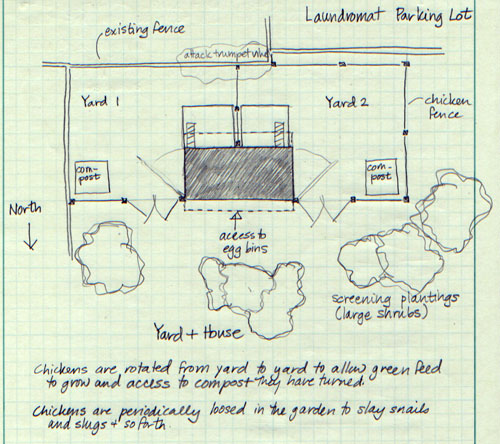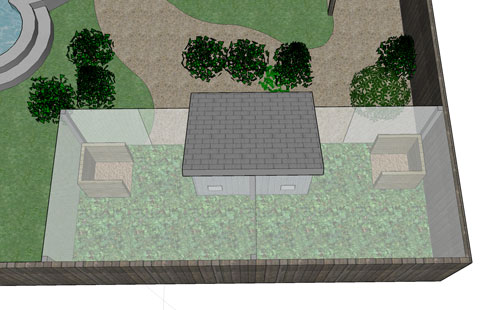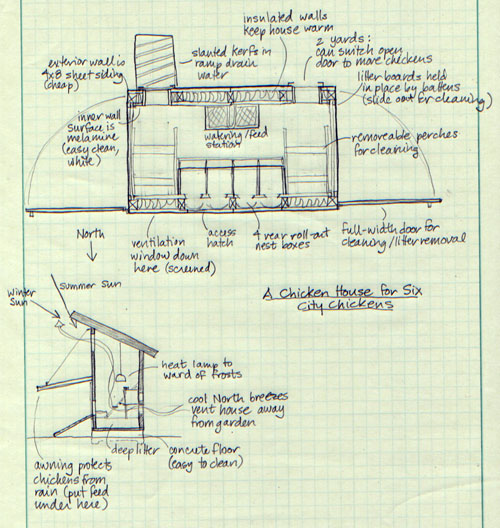The World's Most Overdesigned Chicken House
We plan to get some chickens as soon as I am done with school and back in residence full-time. I am not terribly fond of chickens or pretty much any birds as far as their personalities go, but I want to get them because a) chicken poop, b) hey, did you know chickens will turn your compost pile for you? c) chickens like to eat snails and slugs and Japanese beetles, and d) fresh eggs. Yes, I am primarily getting chickens to be my little garden slaves. I don't eat chicken, and Noel rightly points out that they will become pets in short order, so we have no plans to eat the chickens.
So in view of the future chickens, I have been designing the chicken house (one of the things about livestock: it is best to have their housing all set up before you get to the season to bring them home, because they grow up fast -- faster than I can build a chicken house on weekends). I want to build most of this over one of my holidays this summer, at least getting the enclosure built so I can plant trees and shrubs around it. Also, I could hide potted plants like the experimental grapes in the yard to keep them safe from rampaging dogs. I cannot count the number of times that idiot Rosie has playfully grabbed a stake from a pot to play with it, dragging the grape it was tied to across the yard behind her.
I have been redesigning the back of the garden to account for the fact that we are unlikely to build a shed there anytime in this lifetime, and I don't like looking at that fence. One side was already planned as a utility area, so I just expanded it a little. The chicken house will be at the back of the yard, where the compost pile is now, and the compost pile will be in the chicken yard. Actually, there will be two compost piles, one in each of two yards, so that while one pile is in progress, we can be using up the other. The two yards will allow us to grow green feed -- plants that are good for chickens to eat -- on one side while the chickens obliterate the greenery we've just grown on the other side.

And rendered, minus some detail in the hand drawing:

Tangent: I showed these drawings to a friend and she said, "You can have a couple rabbits on the other side when the chickens aren't there" (that is the setup they have at Annie's Annuals, basically). All this because my eternal quest for rabbit poop for the compost bin has become legend. However, I have secured a reliable local source for bunny poop that doesn't not require me to get my own rabbit and have to deal with having a rabbit. Rabbits will not turn compost or eat slugs. I am not getting rabbits. Not not not.
These are not going to be free range chickens. Every now and then we will let them loose in the main yard to forage, but not unsupervised or all the time. I value my plants too much to let the chickens roam free in the yard all the time. Besides, the threat of avian flu is significant enough that I want to keep the chickens out of reach of wild birds. And chickens can fly, though they tend not to, and I'm not keen on collecting the little buggers from various neighbors' yards every evening. I can put a wire roof on the chicken yards, and they will be safe and contained.
Here's the latest iteration of the drawings for building the house, plus my notes on some design details I chose and why. There's a lot of variation out there in chicken houses, and I'm not trying to build the ultimate chicken house, just one that I will find easy to use and that will do the job of housing my chickens.
My chicken house is based on a 4x8 sheet of plywood as a module. Not only does that mean less cutting, but it makes designing easier. Everything is based on a grid of one-foot squares, which is coincidentally the size, roughly, of one chicken-space. I designed a concrete floor, both because it is easy to clean and because it reduces the problem of rot in the structure. Of course, with ten or so inches of litter piled up in there, the rot-resistance of the floor may well be moot.

There's room for twelve chickens in the house, but we are limited to six by the city. I do hope to change that, but right now it's not a huge concern because six chickens can produce all the chicken poop I want, and far more eggs than we can consume, plus they can do plenty of damage to the slug population.
Both sides of the chicken house open up for cleaning out the litter (I'm planing to use pine chips because they are cheap and come well-recommended for chicken litter), which will be added to the compost to make it burn hot. Inner wall surfaces will be melamine or some other similar smooth sheet good for ease of cleaning. Feedback from other chicken people says that leaving the walls open makes it hard to clean inside, even if is easier to build, and covering the inside walls gives me a place to put insulation. It only gets down to 20 degrees Fahrenheit here, but that's pretty cold when you have no heater, as I can attest after living in the house under the same conditions.
There are two chicken doors that can be locked up to control which yard they can go into, four nest boxes (way overkill for six chickens, but whatever. Fewer boxes would disturb my sense of symmetry) that will have roll-out bottoms so collecting the eggs is a matter of opening a hatch on the back. Two removable roosts, plus a roost over the nest boxes (chickens like to be up high). A little watering stand with an automatic filler. Feeding will happen out in the yard. I'll probably also build them some sort of roost in the yard. I'd like to find some large gnarly branch or something and make them a chicken tree.
The house is sited to take advantage of prevailing breezes for venting (chickens produce a huge amount of moisture) and to allow sunlight to warm the house in winter but block it in the summer. I'll put covers on the vents so that in really cold weather I can shut the wind out and the girls can huddle under a heat lamp.
It's interesting designing a house for chickens after five years of architectural schooling. It certainly gives you a different perspective on even a utility shack.
Technorati Tags: chickens, compost, urban farming
posted by ayse on 05/21/06